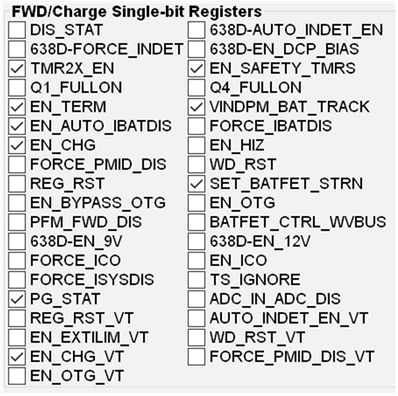SLUUCR0A September 2023 – December 2023
3.2.4 Boost Mode Verification
Use the following steps for boost mode verification:
- Turn off and disconnect PS #1.
- Set Load #1, the battery simulator, to 3.7V and 2 A current limit. Note: If Load #1 connected from BATTERY-J4(3) to GND-J4(1) is not a four quadrant supply, then remove Load #1 and use PS #1, set to 3.7V, 2 A current limit and connect to BATTERY-J4(3) and GND-J4(1).
- In the EVM software on the 16-bit tab, confirm that VOTG, the OTG regulation voltage, is set to 5040 mV and IOTG, the OTG current limit, is set to 1000 mA.
- In the EVM software on the 8-bit tab, check

- Connect Load #2 across VPMID-J3(1) and PGND-J3(2).
- Set Load #2 to 500 mA constant current load and the turn on the load.
- To confirm the VOTG regulation,
- Measure→ VBUS = 5040 mV + 155 mV
- Turn off and disconnect the power supply.
- Remove Load #2 from the connection.
